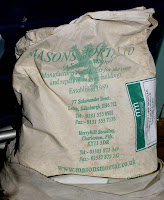
At last, some sunny weather and a chance to put the lime plaster finish on the oven.
As mentioned in the previous section, lime plaster is the preferred finish to the oven, because it breathes. We searched the internet for information on lime plaster mixes and ended with too much data and too many formulae.
Many different mixes are given, from 1:2, lime to sand, to 1:9. There are accounts of the Romans and their addition of 'pozzolan' to produce a lime mortar mix which has lasted 2,000 years. Pozzolan is volcanic ash. Apparently, brick dust will do a similar job, and cement will too. I read of the addition of chopped hair, animal hair, human hair is too fine, to the lime plaster mix, and of chopped straw.
In the end we made our own mix, starting with a bag of lime mortar dry ready-mix of 1 to 2.1/2, lime to sand, bought online from Masons Mortar. We added about another 1.1/2 of coarse sand; about 1/8th of wood ash, the same of chopped straw, and of cement. This mix was put on about 1" thick.
Why lime?
from The Lime Plastering Company's site:
Lime delivers its hardness and its waterproofing qualities through a process called carbonation. The raw lime mortar sits wet on the wall for several days while it absorbs carbon from the abundant atmospheric CO2 and the curing process begins from the outside inwards. In three or four days the outer surface will be hard to the touch and in ten you will need a chisel to scratch it. Over the next weeks and months the lime will gradually continue this bonding and binding process to form a tough water repellent surface, converting this atmospheric carbon to seal to a fine, flexible finish of ninety-five percent pure calcium carbonate and in the process it will have removed a good portion of CO2 from the surroundings. The longer this process continues, the harder and deeper the set becomes, reaching a micro-porous finish that permits the outflow of moisture by evaporation from within the walls, while preventing the larger molecules of liquid rain from penetrating the structure.
As the lime cures and maybe in later years also, you may find, under close inspection, that tiny cracks have appeared in your lime mortar or render, but these cracks belong to the life cycle of a lime build and though you may not immediately see it, the carbonation process is continuing, for wherever 'new' lime is exposed, ie; in weather cracks or other damage, the lime simply takes in more CO2 from the air around and seals the wound by exactly the same process through which it set hard in the first place.
Making an earth oven. Part 1
Making an earth oven. Part 2
See all Parts.



No comments:
Post a Comment